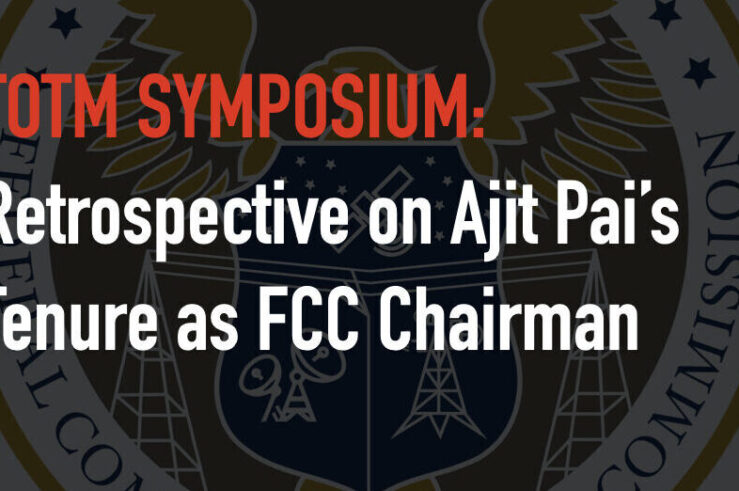The FTC’s UMC Statement Creates a Target for Federal Courts
The Federal Trade Commission’s (FTC) recently released Policy Statement on unfair methods of competition (UMC) has a number of profound problems, which I will detail below. But first, some praise: if the FTC does indeed plan to bring many lawsuits challenging conduct as a standalone UMC (I am dubious it will), then the public ought ... The FTC’s UMC Statement Creates a Target for Federal Courts
A Reflection on Commissioner Pai, Chairman Pai, and Public Service
Much of this symposium celebrates Ajit’s contributions as chairman of the Federal Communications Commission and his accomplishments and leadership in that role. And rightly so. But Commissioner Pai, not just Chairman Pai, should also be recognized. I first met Ajit when we were both minority commissioners at our respective agencies: the FCC and Federal Trade ... A Reflection on Commissioner Pai, Chairman Pai, and Public Service
Wright, Ginsburg, Lipsky and Yun: Connecting Vertical Merger Guidelines to Sound Economics
After much anticipation, the Department of Justice Antitrust Division and the Federal Trade Commission released a draft of the Vertical Merger Guidelines (VMGs) on January 10, 2020. The Global Antitrust Institute (GAI) will be submitting formal comments to the agencies regarding the VMGs and this post summarizes our main points. The Draft VMGs supersede the ... Wright, Ginsburg, Lipsky and Yun: Connecting Vertical Merger Guidelines to Sound Economics
A Bargaining Model v. Reality in FTC v. Qualcomm: A Reply to Kattan & Muris
Introduction In a recent article[1] Joe Kattan and Tim Muris (K&M) criticize our article[2] on the predictive power of bargaining models in antitrust, in which we used two recent applications to explore implications for uses of bargaining models in courts and antitrust agencies moving forward. Like other theoretical models used to predict competitive effects, complex bargaining models ... A Bargaining Model v. Reality in FTC v. Qualcomm: A Reply to Kattan & Muris
Commissioner Wright Responds to Section 5 Symposium
I’d like to thank Geoff and Thom for organizing this symposium and creating a forum for an open and frank exchange of ideas about the FTC’s unfair methods of competition authority under Section 5. In offering my own views in a concrete proposed Policy Statement and speech earlier this summer, I hoped to encourage just ... Commissioner Wright Responds to Section 5 Symposium
Off to the FTC and a Blogging Hiatus from TOTM
As Geoff mentioned, I was fortunate enough to be confirmed by the Senate yesterday as Commissioner of the Federal Trade Commission. I’m excited about the opportunity and very much looking forward to getting started in the new job. Unfortunately, this means I will be taking a hiatus from blogging here at TOTM for awhile. ... Off to the FTC and a Blogging Hiatus from TOTM
Ginsburg & Wright on Behavioral Law and Economics: Its Origins, Fatal Flaws, and Implications for Liberty
My paper with Judge Douglas H. Ginsburg (D.C. Circuit; NYU Law), Behavioral Law & Economics: Its Origins, Fatal Flaws, and Implications for Liberty, is posted to SSRN and now published in the Northwestern Law Review. Here is the abstract: Behavioral economics combines economics and psychology to produce a body of evidence that individual choice behavior ... Ginsburg & Wright on Behavioral Law and Economics: Its Origins, Fatal Flaws, and Implications for Liberty
Free Uber
From the NY Times: Uber, a company based in San Francisco, is introducing a smartphone app to New York that allows available taxi drivers and cab-seeking riders to find one another. The company said the service would begin operating on Wednesday in 105 cabs — a bit less than 1 percent of the city’s more ... Free Uber
Some Links
Competition on layaway fees Price discrimination over restaurant reservation times (HT: NY Times) Steve Calabresi & Larissa Price on the history of government granted monopolies and the constitution A settlement in the EU E-books investigation?
“The prospect of O’Bannon v. NCAA radically reshaping college sports is real”
Michael McCann (Vermont, CNNSI) has a very interesting column on developments in Ed O’Bannon’s lawsuit against the NCAA. O’Bannon is challenging the NCAA’s licensing of the names, images and likenesses of former Division I college athletes for commercial purposes without compensation or consent. McCann discusses the implications of O’Bannon’s motion to expand the class to ... “The prospect of O’Bannon v. NCAA radically reshaping college sports is real”
Welcome TOTM Guest Blogger Adam Mossoff
My GMU colleague Adam Mossoff has been on and around the blogs this week — or at least, other people have been writing about him and particularly about his new paper The Trespass Fallacy in Patent Law. For example, here are a few reactions at Prawfsblawg and Patently-O. I’ve been trying to get Professor Mossoff on ... Welcome TOTM Guest Blogger Adam Mossoff
Attention Economists and Economics Graduate Students: Want to Go to Law School for Free?
I have recently joined my colleague Bruce Johnsen as co-director of the Robert A. Levy Fellowship in Law and Liberty at GMU Law. It is a very generous fellowship — a tuition waiver plus a generous stipend — for economists who have their PhD’s or “ABD” status to come to law school on our dime along with ... Attention Economists and Economics Graduate Students: Want to Go to Law School for Free?







